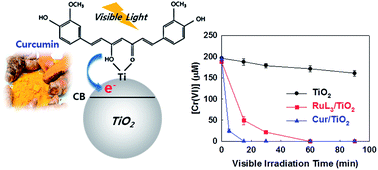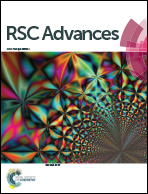Visible light sensitization of TiO2 nanoparticles by a dietary pigment, curcumin, for environmental photochemical transformations†
Abstract
The use of curcumin, an active ingredient of turmeric powder (a dye component in curry), as a TiO2 photo-sensitizer was investigated in terms of the photochemical and photoelectrochemical (PEC) properties. Owing to its strong visible light absorption and strong surface complexation, the curcumin-sensitized TiO2 composite exhibited notable activities for the photochemical degradation of organic compounds, the reduction of chromate (Cr(VI)), and the generation of OH radicals and H2O2 through the reduction of O2 under visible light (λ > 420 nm). Various spectroscopic methods confirmed the anchoring of curcumin on TiO2 and the photochemical and PEC properties of curcumin/TiO2 were compared with those of TiO2 sensitized by a ruthenium complex (RuL3) that has been frequently employed as a visible light sensitizer. Curcumin/TiO2 exhibited consistently higher photochemical and PEC activities than RuL3/TiO2 over a wide pH range in an aquatic environment. These results confirm the practical viability of using a natural food dye, curcumin, as an efficient, eco-friendly, and cheap photo-sensitizer of TiO2 for solar environmental applications. However, it should be noted that curcumin on TiO2 like other dye sensitizers is degraded as a result of the sensitizing reactions in water and should be considered as a sensitizing reagent, not a photocatalyst.



 Please wait while we load your content...
Please wait while we load your content...